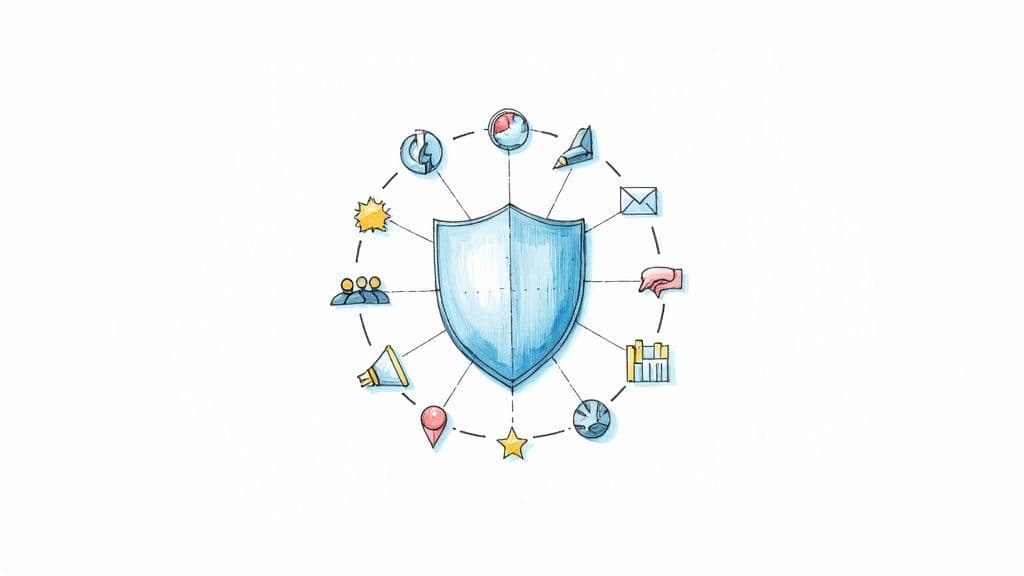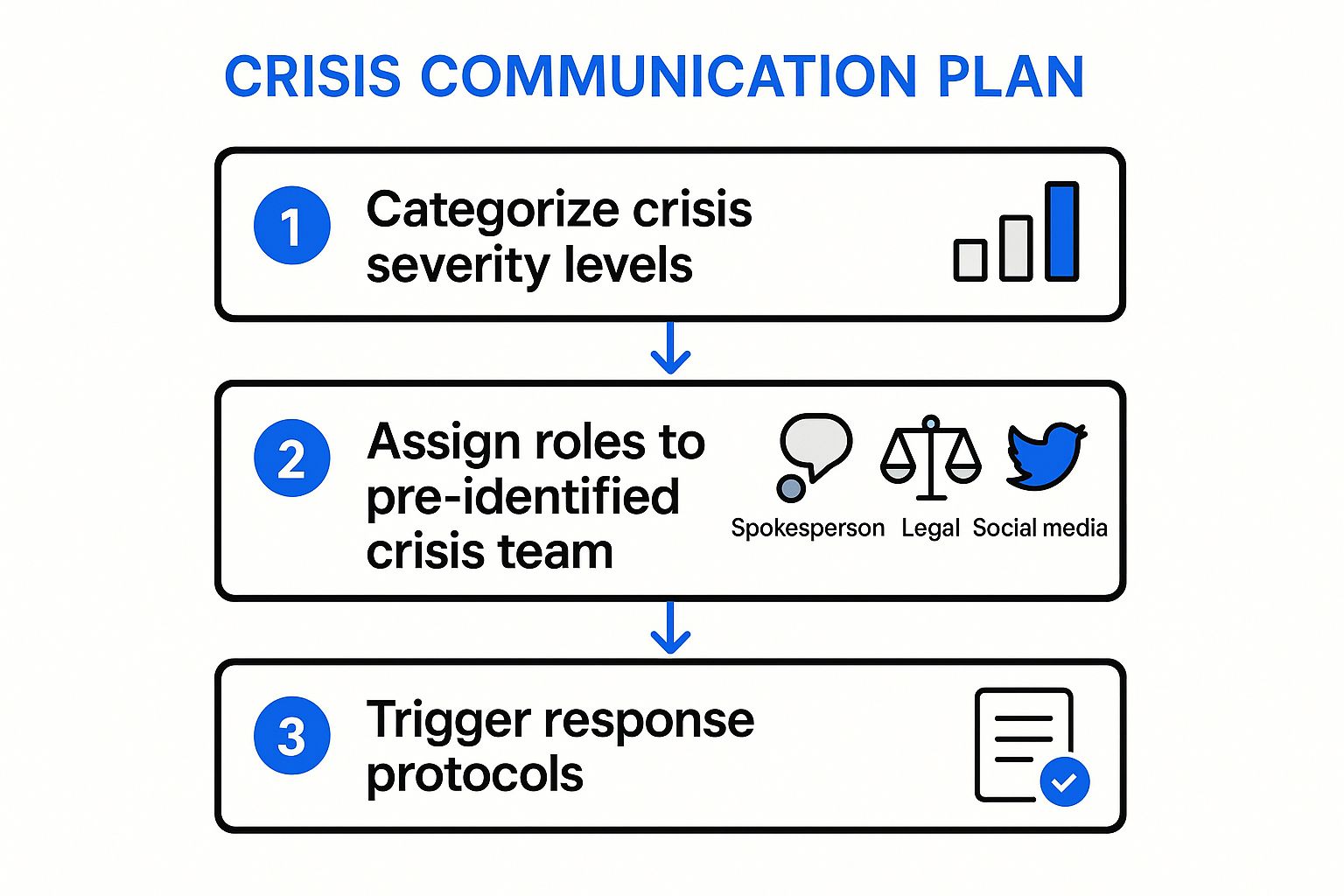9 Reputation Management Best Practices for Startups in 2025
October 10, 2025

In today's hyper-connected marketplace, your brand's reputation is built-or broken-in real time. Every review, tweet, and news article contributes to a public narrative that directly impacts customer trust, investor confidence, and your bottom line. Simply reacting to problems as they arise is no longer a viable strategy. A proactive approach built on proven reputation management best practices is essential for survival and growth, especially for startups and PR teams looking to establish a strong foothold.
This guide moves beyond generic advice to provide a comprehensive roundup of nine actionable strategies. We will deliver concrete steps, real-world examples, and the specific tools you need to build a resilient and respected brand. From implementing continuous online monitoring to fostering a powerful employee advocacy program, these practices will empower you to take control of your brand's story.
Ultimately, mastering these techniques will help you turn your public perception from a potential liability into your most powerful competitive advantage. We will explore how to manage feedback, create positive content, and prepare for crises, ensuring you are equipped to not only protect your reputation but also to enhance it strategically.
1. Monitor Your Online Presence Continuously
You can't manage what you don't measure. Continuous online monitoring is the foundational practice of modern reputation management, acting as your brand's early-warning system. It involves systematically tracking mentions of your company, products, key executives, and relevant keywords across the digital landscape. This includes social media, review sites, news outlets, blogs, and forums. Without this constant vigilance, you're essentially flying blind, unable to amplify positive sentiment or mitigate negative feedback before it escalates.
This proactive approach is crucial for identifying potential crises and opportunities in real-time. By catching a negative review or an inaccurate news story early, you can respond swiftly and control the narrative. This is one of the most critical reputation management best practices because it shifts your strategy from reactive damage control to proactive brand stewardship.

Real-World Impact of Monitoring
Consider Domino's Pizza's famous "Pizza Turnaround" campaign. By monitoring social media, they uncovered widespread customer dissatisfaction with their product quality. Instead of ignoring the criticism, they embraced it, publicly revamped their recipe, and launched a transparent marketing campaign that transformed their brand perception and boosted sales significantly.
Conversely, United Airlines' slow response to the viral "United Breaks Guitars" video demonstrated the cost of inadequate monitoring. The video amassed millions of views before the company formally responded, resulting in a PR nightmare and a reported 10% drop in their stock price.
Actionable Monitoring Tips
To effectively implement continuous monitoring, startups and PR teams should:
- Start with Free Tools: Set up Google Alerts for your brand name, key executives, and primary products. This is a simple, no-cost first step.
- Invest in Dedicated Platforms: For comprehensive coverage, use specialized tools like Brand24, Mention, or Brandwatch. These platforms track a wider range of sources and provide sophisticated sentiment analysis.
- Expand Your Keywords: Monitor common misspellings and variations of your brand name. Also, track industry-specific hashtags and competitor names to understand the broader conversation.
- Establish a Triage System: Create a tiered alert system that prioritizes mentions based on the source's influence and the sentiment's severity, ensuring high-impact issues get immediate attention.
2. Respond Quickly and Professionally to Negative Feedback
Ignoring negative feedback is like ignoring a fire; it will only grow and cause more damage. A swift, professional response to criticism demonstrates that you value customer feedback and are committed to resolving issues. This practice involves establishing clear protocols for timely, empathetic, and solution-oriented replies to complaints across all channels, from review sites to social media. A well-handled complaint can transform a disgruntled customer into a loyal advocate.
This approach is one of the most powerful reputation management best practices because it directly addresses problems in public view, showcasing your brand's integrity and customer service commitment. Instead of letting a negative comment fester, you seize the opportunity to control the narrative and demonstrate accountability. This transparency builds trust with both the individual and the wider audience observing the interaction.

Real-World Impact of Professional Responses
Zappos built its brand on legendary customer service, empowering representatives to resolve issues creatively and empathetically, turning negative experiences into positive folklore. Similarly, Chewy.com often responds to negative reviews with personalized solutions and is known for compassionate gestures like sending flowers when a customer's pet passes away, creating profound brand loyalty.
A classic example of exceptional responsiveness is Morton's Steakhouse, which famously delivered a porterhouse steak to a customer at Newark airport after he jokingly tweeted a request. This single, proactive response generated massive positive press and showcased the incredible power of listening and acting quickly on social media.
Actionable Response Tips
To effectively manage negative feedback, startups and PR teams should:
- Set a Time Goal: Aim to respond within 24 hours on most platforms, but prioritize social media for a response within just a few hours.
- Acknowledge and Apologize: Always thank the person for their feedback first. Offer a sincere apology for their negative experience without making excuses.
- Offer a Solution: Propose a specific, concrete solution to their problem. For complex issues, invite them to continue the conversation privately via email or direct message to resolve it.
- Never Argue Publicly: Getting into a defensive or argumentative exchange in a public forum is a cardinal sin of reputation management. Stay calm, professional, and solution-focused.
- Train Your Team: Ensure everyone who might interact with customers is trained on the brand's voice, response protocols, and when to escalate an issue.
3. Proactively Build and Maintain Positive Content
Effective reputation management isn't just about reacting to negativity; it's about actively shaping your brand’s narrative. Proactively building a library of positive content is like constructing a digital fortress. This strategy involves consistently creating and promoting high-quality, positive assets that highlight your brand’s value, expertise, and culture. By dominating the first page of search results with content you control, you can push down potential negative items and establish a strong, positive first impression.
This approach is one of the most powerful reputation management best practices because it puts you in the driver's seat. Instead of waiting for a crisis to define you, you create a rich digital footprint that reflects your desired brand image. When someone searches for your company, they should find a wealth of valuable, brand-aligned information that reinforces trust and credibility.

Real-World Impact of Proactive Content
HubSpot is a prime example of this strategy in action. By publishing an extensive library of free educational content, including blogs, e-books, and certification courses, they established themselves as the definitive experts in inbound marketing. This content-first approach not only built their reputation but also became their primary engine for lead generation and customer acquisition.
Similarly, Patagonia reinforces its brand values by consistently publishing content focused on environmental activism and corporate responsibility. Their "Worn Wear" program and "The Cleanest Line" blog aren't just marketing; they are authentic extensions of their mission, creating a powerful positive reputation that resonates deeply with their target audience.
Actionable Content Tips
To proactively build your positive online presence, your startup and marketing teams should:
- Diversify Your Content Channels: Establish a presence on multiple platforms where your audience is active, such as a company blog, a YouTube channel, a Medium publication, and key social media profiles.
- Optimize Everything for Search: Ensure all content, from blog posts to video descriptions, is optimized with branded keywords to dominate search engine results pages (SERPs).
- Humanize Your Brand: Share employee stories, behind-the-scenes content, and company culture highlights. This builds an authentic connection with your audience.
- Encourage User-Generated Content (UGC): Actively solicit and showcase customer testimonials, case studies, and positive reviews to build social proof and third-party validation.
4. Encourage and Showcase Positive Reviews and Testimonials
Proactively building a library of positive feedback is a cornerstone of effective reputation management. This practice involves systematically requesting reviews from satisfied customers and strategically showcasing them across key digital touchpoints. Positive reviews act as powerful social proof, directly influencing potential customers, boosting search engine rankings, and creating a buffer that dilutes the impact of any inevitable negative feedback.
By turning happy customers into active advocates, you build a resilient brand narrative grounded in authentic user experiences. This is one of the most vital reputation management best practices because it transforms reputation from a defensive game into an offensive asset. It not only mitigates risk but also actively drives growth by reinforcing trust and credibility at every stage of the customer journey.
Real-World Impact of Showcasing Reviews
Amazon built its e-commerce empire on the foundation of customer reviews. By incorporating them directly into product pages, complete with "Verified Purchase" badges, they created a trusted ecosystem that helps buyers make informed decisions, which has been a massive driver of their success. Similarly, Airbnb's two-way review system fosters a community of trust between hosts and guests, making people feel secure enough to transact with strangers.
On the B2B side, Slack accelerated its early growth by prominently featuring testimonials from recognizable brands on its website. Seeing names like IBM and Oracle using the platform provided immediate validation for new enterprise clients, dramatically shortening the sales cycle and establishing credibility in a competitive market.
Actionable Tips for Generating and Highlighting Reviews
To effectively build and leverage social proof, startups and marketing teams should:
- Time Your Ask: Request reviews at moments of peak customer satisfaction, such as immediately after a successful product delivery, a resolved support ticket, or achieving a key milestone with your service.
- Simplify the Process: Make it incredibly easy for customers to leave feedback. Provide direct links to your preferred review platforms (Google, Yelp, Capterra, etc.) in your email or SMS requests.
- Feature Reviews Prominently: Embed your best reviews directly on your homepage, product pages, and dedicated landing pages. Create a testimonials section that showcases diverse customer stories.
- Respond and Engage: Show your appreciation by publicly responding to positive reviews. This not only encourages the original reviewer but also shows potential customers that you value feedback. This engagement can be a powerful tool as you learn more about building brand awareness.
5. Develop a Crisis Communication Plan
A crisis communication plan is a blueprint for survival in a high-stakes reputation-threatening event. It is a documented strategy that outlines precisely how your organization will respond, removing guesswork and panic from the equation. The plan details designated spokespeople, pre-approved messaging frameworks, escalation procedures, and internal and external communication channels. Having this in place enables a rapid, coordinated, and composed response, which is essential for minimizing reputational damage and projecting competence under pressure.
Failing to prepare for a crisis is preparing to fail publicly. This documented approach is one of the most vital reputation management best practices because it transforms a chaotic, reactive situation into a managed, strategic process. It ensures every stakeholder knows their role, enabling the organization to speak with one clear, consistent, and reassuring voice when it matters most.
The following process flow infographic outlines the core steps to activate during a crisis, from initial assessment to deploying a coordinated response.

This visual guide emphasizes how a structured protocol allows for a swift and organized response, ensuring the right people are activated with the right message.
Real-World Impact of Crisis Planning
The gold standard remains Johnson & Johnson's handling of the 1982 Tylenol crisis. Their immediate product recall and transparent public communication, guided by a clear plan, ultimately strengthened public trust. In contrast, Target's delayed and poorly coordinated response to its 2013 data breach showcased the high cost of inadequate planning, resulting in severe brand damage and financial loss. More recently, Starbucks' swift action after a 2018 racial bias incident, including closing 8,000 stores for training, demonstrated a commitment to addressing the issue head-on, a move enabled by a responsive crisis framework.
Actionable Crisis Planning Tips
To build a resilient crisis communication plan, startups and PR teams should:
- Create a Crisis Team: Form a dedicated team with clearly defined roles (spokesperson, legal counsel, social media manager, etc.) and a contact tree with backup personnel.
- Develop Messaging Templates: Prepare pre-approved holding statements and messaging frameworks for various potential scenarios (data breach, product recall, executive misconduct).
- Conduct Simulation Exercises: Run an annual crisis simulation or "fire drill" to test the plan's effectiveness and identify weaknesses in a controlled environment.
- Establish Protocols: Document clear approval processes for all public statements and establish social media pause/approval protocols to prevent miscommunication during a crisis. For a deeper dive, learn more about crisis communication best practices on pressbeat.io.
6. Engage Authentically with Your Community
Authentic engagement is about building relationships, not just broadcasting messages. It involves creating genuine, two-way conversations with your customers and followers, treating them as valued community members rather than just sales targets. This approach fosters loyalty and transforms customers into brand advocates who are more likely to defend your reputation during a crisis.
By prioritizing human connection over purely promotional content, you build a reservoir of goodwill. This is one of the most powerful reputation management best practices because it creates a resilient community that provides a buffer against negative sentiment and amplifies positive narratives, making your brand stronger and more trustworthy.
Real-World Impact of Engagement
Glossier, the billion-dollar beauty brand, was built almost entirely on authentic community engagement. Founder Emily Weiss leveraged Instagram to co-create products with followers, making them feel like integral parts of the brand's journey. This strategy built an intensely loyal community that drives brand perception.
Similarly, LEGO's Ideas platform allows fans to submit and vote on new product concepts. By turning popular fan designs into official sets, LEGO demonstrates that it actively listens to and values its community, solidifying its reputation as a company that collaborates with its customers rather than just selling to them.
Actionable Engagement Tips
To effectively engage with your community, startups and PR teams should:
- Develop a Human Brand Voice: Create a consistent tone that feels approachable and genuine, not like corporate jargon. Wendy's witty and personal Twitter persona is a masterclass in this.
- Share Behind-the-Scenes Content: Post employee stories, office tours, or the making-of process for a product. This transparency builds trust and makes your brand more relatable.
- Feature User-Generated Content (UGC): Regularly showcase customer photos, reviews, and stories. This not only provides social proof but also makes your community members feel seen and appreciated.
- Ask Questions and Listen: Use polls, Q&A sessions, and open-ended questions to encourage participation. Act on the feedback you receive to show you're truly listening.
7. Maintain Transparency and Ethical Business Practices
Trust is the currency of reputation, and transparency is how it’s minted. This practice involves operating with an open, honest, and ethical framework, communicating clearly about your business operations, decisions, successes, and even failures. By being upfront, you build a deep reserve of goodwill with customers, employees, and investors. This makes stakeholders more likely to give you the benefit of the doubt when challenges inevitably arise.
Adhering to transparency and ethics is a powerful long-term strategy. It shifts your brand from a defensive posture, where you are always reacting to scrutiny, to a proactive one built on credibility. This is one of the most fundamental reputation management best practices because it directly addresses the root causes of many PR crises, preventing them before they can even begin.
Real-World Impact of Transparency
Buffer, the social media management platform, pioneered the concept of "radical transparency." They publicly share everything from employee salaries and equity formulas to their real-time revenue dashboard. This approach has not only attracted top talent but has also fostered a fiercely loyal user base that trusts the company's motives and values.
Similarly, Patagonia's "Don't Buy This Jacket" campaign, which encouraged consumers to consider environmental impact before purchasing, reinforced their ethical commitment. By transparently discussing consumption and their supply chain, they solidified their brand identity and attracted customers who share their values, proving that ethical transparency can be a powerful market differentiator.
Actionable Transparency Tips
To effectively build a culture of transparency and ethics, startups and PR teams should:
- Admit Mistakes Quickly: When something goes wrong, own it immediately. Acknowledge the error, explain what happened, and clearly outline the corrective actions you are taking.
- Make Policies Understandable: Rewrite terms of service, privacy policies, and other legal documents in plain language. Use summaries and FAQs to ensure customers genuinely understand what they are agreeing to.
- Share Both Wins and Losses: Documenting and sharing both successes and failures builds immense credibility. A blog post about a failed product launch can be more valuable for trust-building than one about a major success.
- Create an Impact Report: Publish an annual transparency or social impact report. This document can detail progress toward ethical goals, supply chain audits, diversity and inclusion metrics, and other value-aligned initiatives.
8. Invest in Employee Advocacy and Internal Reputation
Your employees are your most credible and powerful brand ambassadors. Employee advocacy is the practice of empowering your team to represent the organization positively across their personal and professional networks. It recognizes that a strong internal reputation, built on trust and engagement, is the foundation for an authentic external reputation. When employees feel valued, they naturally become the most passionate defenders and promoters of your brand.
This inside-out approach is one of the most effective reputation management best practices because it humanizes your brand and builds trust organically. An employee's authentic endorsement on social media or in person carries more weight than a corporate marketing message ever could. A positive internal culture directly translates into a resilient external brand image.
Real-World Impact of Advocacy
Adobe's structured employee advocacy program is a prime example of success. By providing shareable content and encouraging participation, they increased the reach of their marketing content by 5x through employee shares alone. This demonstrated how a motivated workforce can become a massive organic marketing channel.
Similarly, Salesforce has built an incredibly strong employer brand by encouraging its employees to share their experiences online. Their active advocacy on platforms like LinkedIn reinforces the company's reputation as a great place to work, which in turn attracts top talent and builds customer confidence, showing a direct link between internal culture and external success.
Actionable Advocacy Tips
To build a thriving employee advocacy program, startups and PR teams should:
- Make it Voluntary: Advocacy must be authentic. Never mandate participation. Instead, create a program so valuable and easy that employees want to join.
- Provide Shareable Content: Use platforms like Bambu or EveryoneSocial to curate pre-approved articles, graphics, and updates that make it simple for employees to share.
- Invest in Culture First: As Zappos' legendary CEO Tony Hsieh demonstrated, a world-class employee experience is a prerequisite. A great culture provides the positive stories worth sharing.
- Establish Clear Guidelines: Create a social media policy that empowers and guides employees rather than restricting them. Focus on "do's" instead of just "don'ts."
9. Leverage Data Analytics and Reputation Metrics
Data is the backbone of any credible reputation strategy, transforming it from a guessing game into a measurable science. This practice involves systematically tracking, analyzing, and reporting on reputation-related data to inform decisions and demonstrate ROI. By focusing on key metrics like sentiment scores, share of voice, and brand perception survey results, you can move beyond anecdotal evidence and make strategic, data-driven choices. This is one of the most vital reputation management best practices for proving value and securing executive buy-in.
Tracking these metrics allows you to quantify the impact of your efforts, identify emerging issues before they escalate, and continuously refine your approach. It provides a clear, objective view of how your brand is perceived in the market, enabling you to pinpoint strengths, weaknesses, and opportunities for improvement with precision.
Real-World Impact of Data Analytics
Following various reputation challenges, Airbnb began rigorously monitoring trust and safety metrics. The company created executive dashboards to track key indicators, allowing leadership to make informed decisions that directly addressed public concerns and rebuilt consumer confidence. Similarly, Coca-Cola uses advanced analytics to measure brand health across more than 200 countries, using this data to inform its global and local marketing strategies effectively.
This contrasts with brands that operate on gut feelings and are often caught off guard by shifts in public opinion. Without data, they lack the foresight to adapt their strategies, leaving them vulnerable to reputational harm that could have been mitigated with proper analytics.
Actionable Analytics Tips
To effectively integrate data analytics into your reputation management, PR and marketing teams should:
- Establish Baseline Metrics: Before launching any new initiative, measure your starting point. This baseline is crucial for demonstrating improvement over time.
- Create a Reputation Dashboard: Use a tool to consolidate key metrics like sentiment analysis, media mention volume, and review ratings into a single, easily digestible dashboard for leadership.
- Combine Quantitative and Qualitative Data: Pair hard numbers (e.g., number of negative mentions) with qualitative insights (e.g., the specific themes of those mentions) for a complete picture. You can learn more about how to effectively measure these kinds of PR outcomes on pressbeat.io.
- Benchmark Against Competitors: Track your share of voice and sentiment scores relative to your key competitors to understand your position within the industry conversation.
9 Best Practices Comparison Guide
| Strategy | Implementation Complexity 🔄 | Resource Requirements ⚡ | Expected Outcomes 📊 | Ideal Use Cases 💡 | Key Advantages ⭐ |
|---|---|---|---|---|---|
| Monitor Your Online Presence Continuously | Medium to High: Requires tools and dedicated personnel | Moderate to High: Monitoring software | Real-time brand sentiment and crisis alerts | Brands needing ongoing reputation vigilance | Early issue detection; competitive intelligence |
| Respond Quickly and Professionally to Negative Feedback | Medium: Protocols and trained staff needed | Moderate: Customer service teams | Improved customer satisfaction and loyalty | Managing negative reviews and complaints timely | Converts critics to advocates; demonstrates care |
| Proactively Build and Maintain Positive Content | High: Continuous content creation and SEO efforts | High: Skilled content creators | Strong, positive brand presence long-term | Organizations building thought leadership and SEO strength | Dominates search results; builds trust via content |
| Encourage and Showcase Positive Reviews and Testimonials | Low to Medium: Automated tools but ongoing effort | Moderate: Review management systems | Increased conversions and social proof | Businesses reliant on reviews for customer trust | Enhances local SEO; powerful social proof |
| Develop a Crisis Communication Plan | High: Requires detailed planning and team coordination | Moderate: Training and communication tools | Faster, coordinated crisis response | Organizations prone to reputation risks and crises | Minimizes damage; ensures consistent messaging |
| Engage Authentically with Your Community | Medium to High: Requires consistent personal engagement | Moderate: Community managers and content | Strong loyalty and emotional brand connection | Brands seeking to deepen customer relationships | Builds advocacy; generates genuine user content |
| Maintain Transparency and Ethical Business Practices | Medium: Needs organization-wide commitment and processes | Moderate to High: Reporting and communication | Deep trust and differentiation | Organizations prioritizing ethics and long-term trust | Builds credibility; attracts like-minded customers |
| Invest in Employee Advocacy and Internal Reputation | Medium: Training and cultural investment needed | Moderate: Platforms and content | Expanded reach and authentic brand promotion | Companies leveraging employees as brand ambassadors | Higher trust; cost-effective brand amplification |
| Leverage Data Analytics and Reputation Metrics | High: Requires analytics tools and expertise | High: Analytics platforms and analysts | Data-driven reputation management and ROI | Data-savvy organizations tracking reputation quantitatively | Objective insights; proactive issue identification |
Turn Your Reputation into a Lasting Advantage
Mastering reputation management isn't a one-time campaign or a quick fix; it's a continuous, strategic commitment woven into the very fabric of your organization. The journey from being a reactive damage-control unit to a proactive brand-building force is built on the consistent application of the principles we've discussed. Each of these reputation management best practices serves as a critical pillar supporting a brand that is not just seen, but respected and trusted.
By embracing this comprehensive approach, you transform your company's reputation from a fragile liability into its most resilient asset. This isn't about simply avoiding negative press. It's about architecting a narrative of credibility, competence, and connection that resonates deeply with customers, partners, investors, and employees alike. The true power lies in how these strategies interconnect: continuous monitoring informs your feedback response, proactive content creation fuels your positive review pipeline, and a strong internal culture naturally generates powerful employee advocacy.
From Strategy to Daily Practice
The path forward can seem daunting, but progress begins with focused action. Don't attempt to overhaul everything overnight. Instead, prioritize based on your current challenges and opportunities.
- For early-stage startups: Begin with the fundamentals. Establish a robust system for monitoring your online presence and make it a priority to encourage and showcase positive reviews. These foundational steps build the social proof necessary for growth.
- For scaling companies: Your focus should shift towards solidifying your position. This is the time to formalize your crisis communication plan and invest seriously in employee advocacy programs. Your team is your greatest asset in scaling your reputation.
- For established enterprises: Leverage your resources to refine and optimize. Dive deep into data analytics and reputation metrics to gain sophisticated insights that can guide your strategic decisions and prove ROI.
Ultimately, these best practices are more than just a checklist; they represent a fundamental mindset shift. It’s a commitment to operating with integrity, listening with intent, and communicating with authenticity. This philosophy moves your brand beyond mere transactions and fosters genuine, lasting relationships with your community.
The effort you invest today in building a stellar reputation is a direct investment in your future. It creates a powerful flywheel effect, attracting top talent, commanding customer loyalty, and instilling investor confidence. A strong reputation becomes your competitive moat, a durable advantage that insulates you during challenges and accelerates your success during periods of growth. It is the silent engine that powers sustainable, long-term value.
Ready to supercharge your proactive content strategy and build a powerful backlog of positive press? PressBeat helps startups and tech companies secure high-authority media coverage and expert features, putting your brand in front of the right audiences. Take control of your narrative and build the reputation you deserve by visiting PressBeat to learn more.